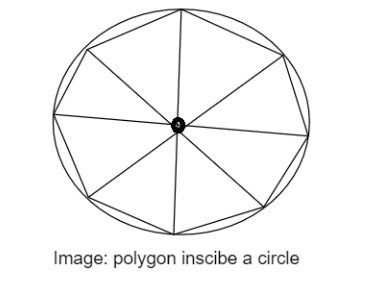
Find the limit of the perimeter of the regular n polygons inscribed in a circle of radius R as $n \to \infty $ .
A.$2\pi R$
B.$4R$
C.$\pi R$
D.$\pi {R^2}$
Answer
217.8k+ views
Hint: First write the formula of the perimeter of a n sided polygon. Then take the limit as $n \to \infty $and calculate to obtain the required result.
Formula Used:
$1 - \cos 2A = 2{\sin ^2}A$
Length of the side of triangle $c = \sqrt {{a^2} + {b^2} - 2ab\cos \theta } $ , where a and b are the lengths of other sides and $\theta $ is the angle made by the angles of length a and b.
Complete step by step solution:
Suppose a regular polygon with n sides is inscribed in a circle of radius R, with the vertices of the polygon touching the circle.
The diagram of the polygon is,

From the center of the circle lines are drawn to each vertex and n triangles are formed.
The lengths of the sides is,
$a = \sqrt {{R^2} + {R^2} - 2.R.R.\cos \dfrac{{2\pi }}{n}} $ , where $\dfrac{{2\pi }}{n}$ is the angle of each triangle at the center.
$ = R\sqrt {2 - 2\cos \dfrac{{2\pi }}{n}} $
$ = R\sqrt 2 \sqrt {2{{\sin }^2}\dfrac{\pi }{n}} $
$ = 2R\sin \dfrac{\pi }{n}$
Therefore, the perimeter is $2nR\sin \dfrac{\pi }{n}$.
As n goes larger the angle $\sin \dfrac{\pi }{n}$approaches $\dfrac{\pi }{n}$ .
Hence the required answer is,
$2nR \times \dfrac{\pi }{n}$
$ = 2\pi R$
Option ‘A’ is correct
Note: In this question the diagram is important, that will help to clear the concept. Always understand the values of a and b in the length formula, as two sides are the radius of the circle so we put R for a and b then calculated the other one.
Formula Used:
$1 - \cos 2A = 2{\sin ^2}A$
Length of the side of triangle $c = \sqrt {{a^2} + {b^2} - 2ab\cos \theta } $ , where a and b are the lengths of other sides and $\theta $ is the angle made by the angles of length a and b.
Complete step by step solution:
Suppose a regular polygon with n sides is inscribed in a circle of radius R, with the vertices of the polygon touching the circle.
The diagram of the polygon is,

From the center of the circle lines are drawn to each vertex and n triangles are formed.
The lengths of the sides is,
$a = \sqrt {{R^2} + {R^2} - 2.R.R.\cos \dfrac{{2\pi }}{n}} $ , where $\dfrac{{2\pi }}{n}$ is the angle of each triangle at the center.
$ = R\sqrt {2 - 2\cos \dfrac{{2\pi }}{n}} $
$ = R\sqrt 2 \sqrt {2{{\sin }^2}\dfrac{\pi }{n}} $
$ = 2R\sin \dfrac{\pi }{n}$
Therefore, the perimeter is $2nR\sin \dfrac{\pi }{n}$.
As n goes larger the angle $\sin \dfrac{\pi }{n}$approaches $\dfrac{\pi }{n}$ .
Hence the required answer is,
$2nR \times \dfrac{\pi }{n}$
$ = 2\pi R$
Option ‘A’ is correct
Note: In this question the diagram is important, that will help to clear the concept. Always understand the values of a and b in the length formula, as two sides are the radius of the circle so we put R for a and b then calculated the other one.
Recently Updated Pages
Arithmetic, Geometric & Harmonic Progressions Explained

Cartesian Form of Vector Explained: Formula, Examples & Uses

Apparent Frequency Explained: Formula, Uses & Examples

Calorimetry: Definition, Principles & Calculations

Centrifugal Force Explained: Definition, Formula & Examples

Charge in a Magnetic Field: Definition, Formula & Examples

Trending doubts
JEE Main 2026: Application Form Open, Exam Dates, Syllabus, Eligibility & Question Papers

Derivation of Equation of Trajectory Explained for Students

Hybridisation in Chemistry – Concept, Types & Applications

Understanding the Angle of Deviation in a Prism

Understanding Collisions: Types and Examples for Students

How to Convert a Galvanometer into an Ammeter or Voltmeter

Other Pages
JEE Advanced Marks vs Ranks 2025: Understanding Category-wise Qualifying Marks and Previous Year Cut-offs

NCERT Solutions for Class 11 Maths Chapter 10 Conic Sections

NCERT Solutions for Class 11 Maths Chapter 9 Straight Lines

NCERT Solutions For Class 11 Maths Chapter 8 Sequences And Series

NCERT Solutions For Class 11 Maths Chapter 12 Limits And Derivatives

Understanding Atomic Structure for Beginners




